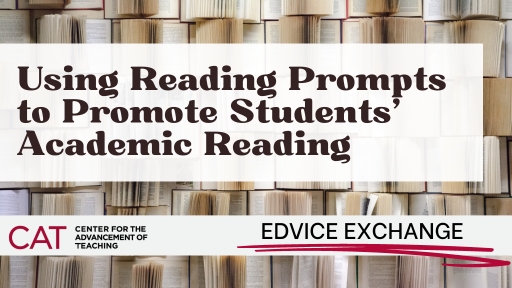Zeenar Salim

Do you have concern around students attending classes without pre-reading? Ever wondered how you can make them read? Students in higher education are expected to comprehend the text, connect their prior experiences with the text, evaluate the text, and consider alternative view-points to the text. Reading prompts are considered to be a way to motivate students to read. It improves students’ comprehension and critical thinking skills by engaging them actively with the reading material.
Provision of reading cues/prompts helps the learners to actively read as well as analyze their own thoughts during and after reading to expand, clarify or modify their existing thinking about the concepts or idea at hand. The reading prompts can be categorized into six categories a) identification of problem or issue b) making connections c) interpretation of evidence d) challenging assumptions e) making applications, and f) taking a different point of view. Sample questions for each category are as follows:
- What is the key issue/concept explained in the article? What are the complexities of the issue? (Identification of problem or issue)
- How is what you are reading different from your prior knowledge around the issue/topic? (Making connections)
- What inferences can you draw from the evidence presented in the reading? (Interpretation of evidence)
- If you got a chance to meet the author, what are the key questions that you would ask the author? (Challenging assumptions)
- What are the lessons for your practice that you have drawn from this reading? (Application)
- If you wrote a letter to your friend who has no expertise in this subject area, how would you explain to him the theoretical concept presented in the article? (Taking a different point of view)
Generally, students are asked to complete the reading prompts before the next class by writing a paragraph-long response to each question. Teachers may ask some or all questions depending upon the learning objectives of the session and may adapt the question(s) to gauge specific information around the text. For more sample questions and detailed literature around reading prompts, please read Tomasek (2009).
Reference
Tomasek, T. (January 01, 2009). Critical Reading: Using Reading Prompts to Promote Active Engagement with Text. International Journal of Teaching and Learning in Higher Education. Retrieved from https://files.eric.ed.gov/fulltext/EJ896252.pdf
Zeenar Salim is a Fulbright PhD Candidate at Syracuse University, where she works at RIDLR (Research in Design Learning Resources).
This post is released under Creative Commons Attribution-NonCommercial-ShareAlike 4.0 International (CC BY-NC-SA 4.0) license.